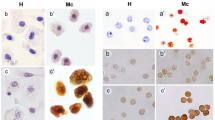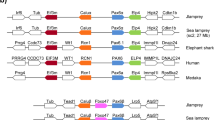Abstract
Haemoglobins and myoglobins constitute related protein families that function in oxygen transport and storage in humans and other vertebrates1,2. Here we report the identification of a third globin type in man and mouse. This protein is predominantly expressed in the brain, and therefore we have called it neuroglobin. Mouse neuroglobin is a monomer with a high oxygen affinity (half saturation pressure, P50 ≈ 2 torr). Analogous to myoglobin, neuroglobin may increase the availability of oxygen to brain tissue. The human neuroglobin gene (NGB), located on chromosome 14q24, has a unique exon–intron structure. Neuroglobin represents a distinct protein family that diverged early in metazoan evolution, probably before the Protostomia/Deuterostomia split.
This is a preview of subscription content, access via your institution
Access options
Subscribe to this journal
Receive 51 print issues and online access
$199.00 per year
only $3.90 per issue
Buy this article
- Purchase on Springer Link
- Instant access to full article PDF
Prices may be subject to local taxes which are calculated during checkout



Similar content being viewed by others
References
Dickerson, R. E. & Geis, I. Hemoglobin: Structure, function, evolution, and pathology (Benjamin/Cummings, Menlo Park, California, 1983).
Stryer, L. Biochemistry (Freeman, New York, 1995).
Hardison, R. C. A brief history of hemoglobins: plant, animal, protist, and bacteria. Proc. Natl Acad. Sci. USA 93, 5675– 5679 (1996).
Gödecke, A. et al. Disruption of myoglobin in mice induces multiple compensatory mechanisms. Proc. Natl Acad. Sci. USA 96, 10495–10500 (1999).
Boguski, M. S., Lowe, T. M. & Tolstoshev, C. M. dbEST–database for “expressed sequence tags”. Nature Genet. 4, 332– 333 (1993).
Makalowski, W., Zhang, J. & Boguski, M. S. Comparative analysis of 1196 orthologous mouse and human full length mRNA and protein sequences. Genome Res. 6, 846–857 (1996).
Waterman, M. R. Spectral characterization of human hemoglobin and its derivatives. Methods Enzymol. 52, 456–463 (1978).
Strittmatter, P. & Burch, H. B. The heme protein in ganglia of Spisula solidissima. Biochim. Biophys. Acta 78, 562–563 ( 1963).
Dixon, B. & Pohajdak, B. Did the ancestral globin gene of plants and animals contain only two introns? Trends Biochem. Sci. 17, 486–488 ( 1992).
Go, M. Correlation of DNA exonic regions with protein structural units in haemoglobin. Nature 291, 90–92 ( 1981).
Hankeln, T., Friedl, H., Ebersberger, I., Martin, J. & Schmidt, E. R. A variable intron distribution in globin genes of Chironomus: evidence for recent intron gain. Gene 205, 151–160 ( 1997).
Logsdon, J. M., Stoltzfus, A. & Doolittle, W. F. Molecular evolution: recent cases of spliceosomal intron gain? Curr. Biol. 8, R560– R563 (1998).
Goodman, M., Moore, G. W. & Matsuda, G. Darwinian evolution in the genealogy of haemoglobin. Nature 253, 603–608 (1975).
Dewilde, S. et al. Globin and globin gene structure of the nerve myoglobin of Aphrodite aculeata. J. Biol. Chem. 271, 19865–19870 (1996).
Simons, P. C. & Satterlee, J. D. cDNA cloning and predicted amino acid sequence of Glycera dibranchiata monomer hemoglobin IV. Biochemistry 28, 8525– 8530 (1989).
Zafar, R. S. et al. The cDNA sequences encoding two components of the polymeric fraction of the intracellular hemoglobin of Glycera dibranchiata. J. Biol. Chem. 265, 21843–21851 (1990).
Zafar, R. S., Chow, L. H., Stern, M. S., Vinogradov, S. N. & Walz, D. A. The heterogeneity of the polymeric intracellular hemoglobin of Glycera dibranchiata and the cDNA-derived amino acid sequence of one component. Biochim. Biophys. Acta 1041, 117–122 (1990).
Wittenberg, B. A., Briehl, R. W. & Wittenberg, J. B. Haemoglobins of invertebrate tissues - nerve haemoglobins of Aphrodite, Aplysia, and Halosydna. Biochem. J. 96, 363–371 ( 1965).
Wittenberg, J. B. Functions of cytoplasmatic hemoglobins and myohemerythrin. Adv. Comp. Environ. Physiol. 13, 60–85 (1992).
Vandergon, T. L., Riggs, C. K., Gorr, T. A., Colacino, J. M. & Riggs, A. F. The mini-hemoglobins in neural and body wall tissue of the nemertean worm, Cerebratulus lacteus. J. Biol. Chem. 273, 16998–17011 (1998).
Kraus, D. W. & Colacino, J. M. Extended oxygen delivery from the nerve hemoglobin of Tellina alternata (Bivalvia). Science 232, 90–92 ( 1986).
Schmidt, R. F. & Thews, G. Physiologie des Menschen (Springer, Berlin, Heidelberg, New York, 1997 ).
Feinberg, A. & Vogelstein, B. A technique for radiolabeling DNA restriction endonuclease fragments to high specific activity. Anal. Biochem. 132, 6–13 (1983).
Rentrop, M., Knapp, B., Winter, H. & Schweizer, J. Aminoacylsilane-coated glass slides as support for in situ hybridisation of keratin cDNAs to frozen tissue sections under varying fixation and pretreatment conditions. Histochem. J. 18, 271–276 (1986).
Studier, F. W., Rosenberg, A. H., Dunn, J. J. & Dubendorff, J. W. Use of T7 RNA polymerase to direct expression of cloned genes. Methods Enzymol. 185, 60–89 (1990).
Thompson, J. D., Gibson, T. J., Plewniak, F., Jeanmougin, F. & Higgins, D. G. The ClustalX windows interface: flexible strategies for multiple sequence alignment aided by quality analysis tools. Nucleic Acids Res. 25, 4876-82 (1997).
Burmester, T. & Hankeln, T. A globin gene of Drosophila melanogaster . Mol. Biol. Evol. 16, 1809– 1811 (1999).
Felsenstein, J. PHYLIP (Phylogeny Inference Package) Version 3.5c (Dept Genetics, Univ. Washington, Seattle, 1993).
Acknowledgements
We wish to thank R. Gebhardt and N. Hellmann for their help with the oxygen-binding studies; G. Ungerechts for his assistance in the cloning; E. Jaenicke for running the FPLC; L. Moens and S. Dewilde for sharing experimental protocols and for discussions; and H. Decker, E. R. Schmidt and J. Markl for excellent working facilities, continuous support and valuable suggestions. This work is supported by the Deutsche Forschungsgemeinschaft (DFG) and the Naturwissenschaftlich-Medizinisches Forschungszentrum (NMFZ) Mainz.
Author information
Authors and Affiliations
Corresponding author
Supplementary information
Rights and permissions
About this article
Cite this article
Burmester, T., Weich, B., Reinhardt, S. et al. A vertebrate globin expressed in the brain. Nature 407, 520–523 (2000). https://doi.org/10.1038/35035093
Received:
Accepted:
Issue Date:
DOI: https://doi.org/10.1038/35035093
This article is cited by
-
Neuroglobin plays as tumor suppressor by disrupting the stability of GPR35 in colorectal cancer
Clinical Epigenetics (2023)
-
An extra-erythrocyte role of haemoglobin body in chondrocyte hypoxia adaption
Nature (2023)
-
Hydrogel oxygen reservoirs increase functional integration of neural stem cell grafts by meeting metabolic demands
Nature Communications (2023)
-
Neuroglobin Facilitates Neuronal Oxygenation through Tropic Migration under Hypoxia or Anemia in Rat: How Does the Brain Breathe?
Neuroscience Bulletin (2023)
-
Peroxidase activity of rice (Oryza sativa) hemoglobin: distinct role of tyrosines 112 and 151
JBIC Journal of Biological Inorganic Chemistry (2023)
Comments
By submitting a comment you agree to abide by our Terms and Community Guidelines. If you find something abusive or that does not comply with our terms or guidelines please flag it as inappropriate.



